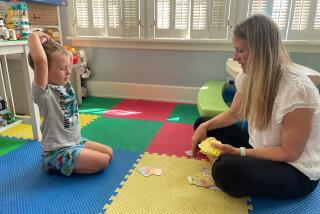Shaping the connection
Children aren’t the only ones showing off at the playground. Parents are on display too: There are the playful moms and dads, swinging on the monkey bars; the bookworms and cell phone gossips, their minds elsewhere; the anxiety-prone, shadowing their child’s every step as if it could be the last; and those who continually bark instructions (“William, now what do we call that? William, what do we say to that boy? William!”).
As natural as it comes to some, parenting is for others a work in progress. In part, psychiatrists say, this is because mothers and fathers often repeat some of the same gestures, patterns and habits of their own parents. These habits are more than mere quirks. As several years-long research studies now show, children who grow up with a warm, stable connection to their parents (or other caregivers) are primed to form the same kind of connection later on, whereas those who start with uncertain or anxious bonds often struggle to forge close relationships as adults, even with their own children.
The study of these parent-child bonds and their consequences is known as attachment theory, a field of psychology that over the years has inspired both scientifically rigorous research and a stream of unsubstantiated, quick-fix parenting therapies, from simple advice to touch and hug children more often to more forceful “rebirthing” techniques to induce attachment. Yet recent studies underscoring the lasting effect of a loving, attentive caregiver have generated a surge of renewed interest among family researchers and therapists about the notion of attachment. More than a dozen new books based on attachment have landed in bookstores over the last year, from parenting guides to scholarly works. A wide range of attachment-based research is underway, from studies of mothers in the San Francisco Bay Area to female prison inmates in Baltimore to low-income families in New York.
“The revolution has happened,” said Victoria Levin, a behavioral research specialist at the National Institutes of Health in Bethesda, Md. “Attachment theory is now the background and backbone of a lot of the work that’s going on in families with young children. This is because researchers who started out studying infants have followed these kids into adolescence. They find that the quality of their original attachment still predicts a child’s competence, the way they interact with other people, how they do in school, whether they have behavior problems, and on and on.”
Current studies attempt to teach parents the theory, in effect, so that they can apply it themselves. At UC San Francisco, Dr. Alicia Lieberman has worked with immigrant families and victims of domestic abuse, showing them how stress and painful memories can interfere with attentive parenting. Jude Cassidy, a psychologist at the University of Maryland, is running a program for about 100 inmates at a Baltimore prison, teaching them how to see their young children’s behavior and body language as attachment students would. And at the Marycliff Institute, a family counseling center in Spokane, Wash., psychologists are significantly improving relations between parents and preschool children in an experiment called the Circle of Security.
Cammy Latimer, an elder-care worker in Spokane, had her hands full with two young children when she heard about this study. Her youngest child, Alyxandria, then 2, was prone to tantrums and defiance. “Once I had a stranger come up to me and actually say something about it,” she said. “It wasn’t much different from what I see other kids do, but at that point I was interested to try anything that could help me with her.”
Latimer liked the fact that the program used a single image -- a circle -- to help explain how attachment worked. From a very early age, the theory goes, children move away from their parents to explore but continually circle back, using their parents as a “secure base.” An infant crawling around a new room continually looks to her parent, for reassurance or attention, and periodically reaches out to be held. Children repeat the same loops -- moving away to explore, reaching or looking back to touch base -- as they get older, whether investigating a playground as a toddler, playing in the backyard with a new friend or phoning from a party.
In theory, the ideal parent does several things: encourages exploration, remains alert for the child’s cues and signals for reassurance or shared emotion, and then responds to those cues by offering comfort.
“It’s a dance between the child and parent, with rhythm and timing, and it’s going on all the time, from a very early age,” said Kent Hoffman, a psychologist at Marycliff who designed the program with two colleagues, Bert Powell and Glen Cooper.
To picture this circle, counselors asked Latimer and Alyxandria to participate in a classic attachment experiment called the Strange Situation. .
As observers watch through two-way mirrors, a mother and young child are led into a small waiting room where a box of toys is in plain view. . The mother then leaves the room, so that the child is alone with the stranger. Infants and toddlers who become upset when their mother leaves and then reunite warmly when she returns are thought to be securely attached. “All sorts of things go on during this interaction, but you’re watching the reunion very closely,” said Dr. Robert Marvin, a researcher at the University of Virginia who is working with the Marycliff group. “What you want to see is for the child to show need openly and for that need to be filled,” by a quick glance, a gesture, a smile, a touch -- any intimate signal. .
However trivial they might seem, these small exchanges are physically shaping a child’s brain and body as he or she grows, new research shows. A mother’s caress or comfort not only lowers the amount of stress hormones circulating in the child’s blood, for instance, it also helps teach the child’s body to regulate its own response to upsetting events in the future.
“The idea is that we are born to form attachments, that our brains are physically wired to develop in tandem with another’s, through emotional communication, beginning before words are spoken,” said Allan Schore, a UCLA behavior specialist and leading attachment expert. “If these things go awry, you’re going to have seeds of psychological problems, of difficulty coping, stress in human relations, substance abuse, those sorts of problems later on.”
The video of the Latimers’ Strange Situation revealed a complex interplay. As her mother stepped out of the room, Alyxandria, though unsettled, continued playing, and she remained absorbed in the toys when her mother came back. At the end of the session, mother and daughter played out a scene familiar to any parent: Asked to put away the toys, Alyxandria resisted and haggled until her mother did the job.
Watching the replay later, Latimer smiled at the sight of Alyxandria’s manipulations and defiance. “Especially when I was in public places, I was very reluctant to have an argument with her, so I let many things slide,” she said. The video suggested that, like many loving parents, Latimer relates to her young daughter in a variety of guises. Sometimes she was the wise, engaged mother, as when reading to her child. Other times she came across more as a friendly partner, a kind of big sister.
In counseling sessions that followed, Latimer was encouraged to expand on the role of wise, strong mother and to reflect on the origins of the mother as friend. “Our belief is that all parents have an inner gyroscope, a North Star” of parenting to guide them, said Hoffman. “The issue is that there are often experiences in our own past that create dissonance when we start to trust that sense of balance.”
Often treated as a friend by her own mother, Latimer recalled taking control of situations when she was very young, even though she wasn’t ready to do so. “I’m still very close to my mother -- we talk every day -- but I could see that with Aly she wanted me to take control and let her know what to do.” At the end of the Marycliff program, the Latimers visited the Strange Situation again, also on videotape. This time the little girl gets visibly upset when her mother leaves. When mom gets back, she jumps in her lap, and the two read a book together for a few minutes. Alyxandria then cleans up all the toys. “I do still get frustrated sometimes, but now it’s like I stand back and remind myself I’m the bigger, stronger, wiser person here,” Latimer said. “I don’t end up screaming at anyone anymore.”
In two years, Hoffman, Cooper and Powell have guided more than 70 parents and their children through the program. Some parents are too reluctant to allow their children to explore, perhaps because their own overprotectiveness is contributing to their toddler’s neediness and reluctance to explore. Others discover they are often too busy multi-tasking on the phone or doing other chores to notice when their children circle back for a comforting smile or remark. The researchers say they have documented significant improvements in attachment in 3 of 4 families.
Those results, while encouraging, are preliminary, the researchers say. It is too soon to know whether the improvements will endure or how well similar attachment programs will work among different groups of parents. L. Alan Sroufe, a child development researcher at the University of Minnesota, says only time will tell. “I do not doubt that people can change -- of course they can. But usually it doesn’t happen quickly.”






